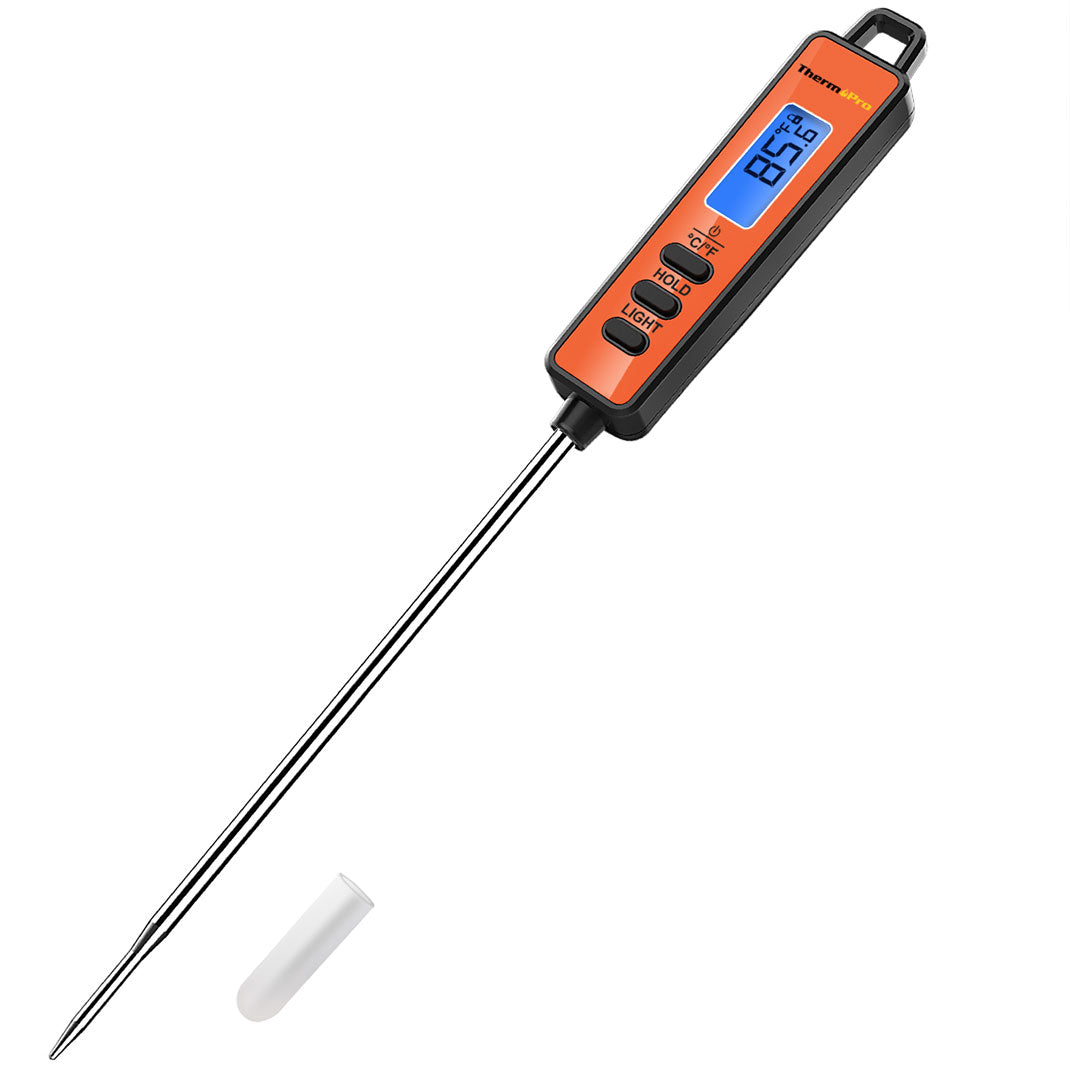How to Clean a Meat Thermometer






 288 Comments
288 Comments
When inserting a meat thermometer into uncooked meat, it seems practical that it should be cleaned before returning it back to its storing place. However, what do you do when you need to clean meat thermometer? Should it be washed off at the end of use or simply rinsed off? When should it be cleaned? And finally, how to clean?
To answer these questions and more concerning how to clean meat thermometer, we have comprised the following thermometer cleaning guide, along with tips from the experts, designed to help you properly clean and sanitize your meat thermometer, so you get the most out of your meat thermometer as well as enjoy safe food.
Why Should We Clean Meat Thermometer?
A meat thermometer is used to test the internal temperature of meat; however, if the meat that is being tested is still raw on the inside or not cooked to a safe minimum internal temperature, it can contaminate the thermometer with harmful microorganisms. Therefore, the thermometer needs to be properly cleaned before storing it and inserting it back into under-cooked meat to gauge the temperature again to avoid contamination.
Furthermore, even if the thermometer is used only to check the internal temperature of fully cooked meats and other foods, it can become caked with grease and other food particles. If the thermometer is used continuously for extended periods of time, the fat attached to it can make it hard to read or generate a proper reading; therefore, the thermometer also needs to be cleaned during extended use to maintain an appropriate reading.
When Should We Clean Meat Thermometer?
Besides the meat thermometer cleaning at the end of use, there are also other times when the meat thermometer needs to be cleaned to remain sanitary, such as if it is being used alternatively to check the internal temperature of uncooked meat and then used to check the temperature of ready-to-eat food.
The meat thermometer should also be cleaned when used alternately to check the internal temperature of cooked foods to remove grease and food particles, which can make the thermometer difficult to read or even affect proper readout.
Some Food Safety Education Specialists also recommend cleaning and sanitizing the thermometer the same way other food-contact surfaces are cleaned, which means at the start of the cooking session, washing and disinfecting the thermometer to ensure added safety prior to use.
How Can We Clean Meat Thermometer?
Here is a detailed YouTube video show you how to clean meat/food thermometer.
And below are the full text and steps to clean different types of food thermometers:
Instant Read Thermometers
Instant-read thermometers, such as the ThermoPro Digital Instant food thermometer, enables you to measure the internal temperatures of meat with the most accurate reading in the quickest time possible.
To clean an instant-read thermometer, wash the stem of the thermometer with soap and hot water to remove any stuck on particles and grease. This will also help destroy most common surface bacteria. However, do not submerge the entire thermometer in water as it may damage the thermometer’s components as well as its reading.
Thoroughly rinse and dry the thermometer before sanitizing it.
Fork thermometers
Fork thermometers, such as the ThermoPro Digital Fork Thermometer, are another type of instant-read thermometer that provides an accurate, fast read out via a sensitive sensor probe. Therefore, you need to take special care when cleaning the device.
To clean a fork thermometer, avoid submerging the device into the water. Instead, simply clean the tines with soap and water to remove food particles and grease. Next, carefully, rinse and dry the tines with a soft towel or paper towel to prepare it for sanitizing.
Digital Meat Thermometers

Digital meat thermometers, such as the ThermoPro Digital Meat Thermometer, also utilize a sensitive digital probe to provide a fast and accurate readout, so it needs to be cleaned with care. Just wash the probe with soap and water, without immersing the device into the water, and then carefully rinse and dry the device to prepare it for sanitizing.
Digital Folding Probe Thermometers

Since digital folding probe thermometers also use a sensitive, electronic probe to provide the most precise and instant readout, it also requires care when cleaning. To clean the device, simply cleanse the probe with soap and water, and avoid immersing the entire device into the water as it can damage the sensitive electronic components. Lastly, gently rinse and dry the device to prepare it for sanitizing.
Glass thermometers
Glass thermometers, which consist of a narrow glass tube that inserts into meats, can acquire their share of grease build-up, which requires them to be thoroughly cleaned after or between uses. Furthermore, when using them to check smoked meats, they can become stained with smoke, which can make them hard to read, in which case, they will also require cleaning.
To clean a glass thermometer, first, try washing the insert with a grease-cutting liquid soap diluted in hot water, and then rinse and dry the device to prepare it for sanitizing. To remove tough, stuck on stains, such as smoke film, check below for the different tricks to clean food thermometers.
Digital Wireless Meat Thermometers

Digital wireless meat thermometers, such as the ThermoPro Wireless Remote Digital Cooking Food Meat Thermometer, which can be used for the grill, smoker, and the oven, can accumulate carbon on the tip, which can insulate the sensor thereby giving it a false reading. Therefore, it is important to keep the probe clean in order to ensure an accurate reading.
To clean a digital wireless thermometer, focusing solely on the last 1″ tip of the probe, use a soapy sponge to remove carbon build-up from the end. However, beware as the sensor is usually located within the lower 1/4″ of the probe. Be sure to keep the smoker probe clean so that it does not accumulate a hazy film, which can make it hard to read.
Different Tricks to Clean Food Thermometers
Occasionally, after applying traditional methods to clean your meat thermometer, you may find that some tougher elements, such as smoke and grease build-up, still remain, or perhaps you’d simply just like a quick and effective way to clean or sanitize your thermometer. When all else has failed, you may consider trying some of the following different tips and tricks, brought to you via various meat thermometer users, to clean your thermometer.
Cooking Spray
To remove tough, stuck on stains, such as smoke build-up, from glass thermometers fellow users suggests spraying a bit of cooking spray or food grade silicon spray onto the stem and then wipe it off. Next, wash the stem with hot, soapy water, rinse, and then dry the thermometer well.
Bar Soap
Some users recommend rubbing a bar soap on the glass insert to remove tough build-up; however, be sure to rinse the stem thoroughly clean to prevent a cloudy film.
Alcohol Wipes
For a quick and effective way to clean and sanitize the thermometer in between use, some users recommend using an alcohol wipe to clean the insert. Just be sure to thoroughly rinse the probe, and allow the alcohol towelette to air dry a bit before use to avoid over-saturation.
White Vinegar
Finally, some users have found that white vinegar placed on a cotton pad or paper towel makes a great alternative to chemical-based thermometer cleansing. Simply wipe the probe with vinegar and then allow it to dry.
How to Sanitize Food Thermometers?
Alcohol Swab
There are various ways to sanitize a meat thermometer. For instance, most environmental health inspectors prefer to sanitize the stem by submerging it in a properly prepared chemical sanitizing solution, or they wipe the stem with an alcohol swab to sanitize the thermometer.
Boiling Water
You could also sanitize the thermometer by holding the stem in boiling water for no less than 30 seconds. The temperature of boiling water is 212-degrees Fahrenheit, which is more than sufficient at destroying harmful bacteria.
Chlorine Bleach and Water
Or, sanitize the stem of the thermometer in a food-safe sanitizing solution, such as chlorine bleach and water, diluted according to the directions on the bottle, by holding it in the diluted mixture for a minimum 10 seconds.
Lastly, wash the stem with soap and hot water to remove any residue and remaining sanitizing solution.
Overall, the best and most effective way to clean your meat thermometer is to gently wash the insert with hot water and soap, and never place the thermometer in the dishwasher or submerge it in water as it can damage the thermometer as well as affect its reading. You should also be sure to sanitize the thermometer after washing it to further ensure its safety; however, when using a chemical solution, such as alcohol or chlorine bleach, be sure to thoroughly wash and rinse the probe to remove any leftover chemical remains.




















